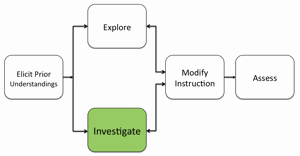Paleoclimate Reconstruction Lab
In this lab investigation, students will reconstruct past climates using lake varves as a proxy. They will explore the use of lake varves as climate proxy data to interpret long-term climate patterns and understand annual sediment deposition and how it relates to weather and climate patterns.

In this 2-day student investigation, the data is divided into 10 core segments, each composed of about 30 varve layers. Core 1 is split into two parts labeled “Core 1a” and “Core 1b”. Both parts should be combined and plotted on the Core 1 graph (Varve Years 5685 to 5715). Varve measurements should be taken in tenths of centimeters (millimeters) starting at the bottom of each core and working upwards. Measurements less than 1 millimeter are recorded in the Measurement Table as 1mm and should be plotted and included on the core graph. Five year increments are marked within each core to help the students stay organized. Measurements should first be transferred to the Measurement Table on the core data handout and then graphed once all of the data has been collected.
1. Present the Paleoclimate Reconstruction Using Lake Varves PowerPoint Slideshow to your students. This PowerPoint slideshow is designed to provide your students with requisite background information on the use of lake varves as a climate proxy. It also provides an overview of the lab investigation’s core data and associated materials to help them understand how to measure and graph the varve data. See Creating a Paleoclimate Record in the Teacher Resources/Content Support section below for additional content background on using lake varves for paleoclimate reconstruction.
2. Tell students they will be investigating a 300 year climate pattern from about 14,500 years ago using lake sediments (varves). They will investigate how proxies can be used to reconstruct past climate patterns.
Note: It is important for the students to understand that the varve years can be scaled to approximate calendar years. As an example, varve year 5685 can be associated with an approximate calendar age of 15,100 years ago.
3. Distribute a Paleoclimate Reconstruction Investigation Guide and a Paleoclimate Reconstruction Core Data Handout to each student. There are 10 core data sheets that are to be distributed to groups of students in the classroom. Students can work individually or in groups of 2. Each of the 10 cores must be measured, recorded, and graphed in order to analyze the entire paleoclimate record. In larger classes, you may wish to have students or student groups complete multiple versions of each core and compare their results with each other as a measurement validation check.
Note: The data measurements for Core 5 are provided. The varve thicknesses for Core 5 are too small to be measured accurately in the classroom. The Core 5 graph (Varve Years 5805 to 5834) will be used later in the investigation during the analysis of the cumulative climate proxy record of all the combined cores.
4. Instruct students to measure the thickness of each varve layer in their core. Each varve year corresponds to the distance between two line segments in a core. Students should record the measurements in the associated Measurement Table beginning with the bottom of the core. Students should measure the thickness of each varve layer and then transfer that measurement to the corresponding year on the Measurement Table.
Note: If the thickness of a varve is less than 0.1 cm, the answer has been pre-recorded in the measurement table. Also, it is much easier to have students measure their cores by starting at the bottom of the core (oldest and smaller year number) and work upwards (youngest and higher year number).
Implementation Suggestion:
- Some lower ability level students might have difficulty using a metric ruler to measure the thickness of each varve layer in their core. Explicit instruction and modeling how to use a ruler to measure a varve year in millimeters and centimeters with multiple examples on a core may be needed. Students may also need explicit instruction and modeling on how to transfer their varve year measurements to the corresponding year on the Measurement Table.
5. After all core measurements have been recorded in the Measurement Table, instruct students to plot their data on the core graph. Varve years are displayed along the x-axis in 5 year increments. Varve thickness in centimeters is plotted on the y-axis.
6. Instruct students to answer Analysis Questions #1-2 in their Investigation Guide.

